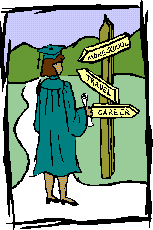
For most adultslearning is related tochange and transitions. |
 |
Research | Models | Variables | Characteristics | Principles | Discussion
Research
Research in this topic area began in the 1960s and continues today. For most adults learning is related to change and transitions. When asked about what triggers learning, almost 85% of adults say a past, present or future transition is their reason for learning.
In 1991 Merriam and Clark published a study about how learning, work, and love are related. (Merriam, 5.B, and Clark, M.C. (1991) Lifelines: Patterns of Work, Love, and Learning in Adulthood)
For this week, concentrate on the following individuals and ideas. You should be able to identify or describe them.
- Johnstone and Rivera study (1962)
- Penland study (1979) Aslanian and Brickell study (1980)
- C. Houle - The Inquiring Mind
- R. Boshier - Education Participation Scale
- P. Cross - Barriers
Some Variables Found In Participation Models
Socioeconomic Class- Adult learners in higher socioeconomic classes are more likely to participate in adult education than an adult learner in lower socioeconomic classes. Miller (1967) relates this difference to the learner's placement on Maslow's Hierarchy of Needs (1954).
Deficiency or Growth Motivation- Boshier (1973) explains the learner's developmental level on Maslow's Hierarchy of Needs with deficiency (satisfying lower, more basic needs) and growth (satisfying higher needs with greater autonomy).
Congruence- The learner's success in affected by their level of congruence with their ideal self, the educator, and other students (Boshier, 1973). The learners' feelings about themselves is a simpler description.
Social and Psychological Variables- Age, sex, and social class fit within this group of variables. Darkenwald and Merriam (1982) based their model on where the learner is with regard to individual and family characteristics in pre-adulthood (age).
Subenvironmental Variables- Transportation, class size, and accessibility of opportunities are examples (Henry and Basile, 1994).
Socialization- The perceptions of the learner as influenced by family, school and work. This variable is introduced by Rubenson (1977) and advanced by Darkenwald and Merriam (1982).
Previous Experience- The learner's experience in formal learning is a common variable in participation models.
Life Transitions- Events and changes in the learner's life cycle was a variable introduced by Cross (1981).
Life Goals- Rubenson (1977) introduced the idea of "expectancy and valence" or the expectations of the learner and the value the learner puts on the learning activity. Many other theorists adopted this variable.
Learning Press- The extent to which an individual's current environment encourages learning. Darkenwald and Merriam (1982) define three categories of variables within learning which include general social participation (civic, cultural, religious, and recreation), occupational complexity (technical, professional, and managerial), and life-style (personal taste, and leisure-time preferences).
Characteristics of Adult Learners
 |
Broad experience base. Busy people. Some face barriers to learning. unlearning unrealistic goals poor self-image diminished physical abilities Sensitive to risking failure. Want relevant information, Like variety in teaching methods. |
Some Basic Principles of Adult Learning
- Adults are a highly diversified group of individuals with widely differing preferences, needs, backgrounds and skills.
- Adults maintain the ability to learn throughout their lives.
- Adults do experience a gradual decline in physical capabilities as they age.
- Experience of the learner is a major resource in learning situations for adults.
- Self-concept moves from dependency to independence as individuals grow in responsibility, experience and confidence.
- Adults tend to be life-centered in their orientation to learning.
- Adults are motivated to learn by a variety of factors.
- Active learner participation in the learning process contributes to learning.
- A comfortable supportive environment is a key to successful learning.
- Most adults are goal-oriented in their learning and usually want to be able to apply their learning immediately.
Discussion Questions
From your experience, what is the hardest barrier to learning you have had to overcome? What transition in your life has triggered the most learning for you? As an adult education practitioner, what will you do to ensure participation in learning?